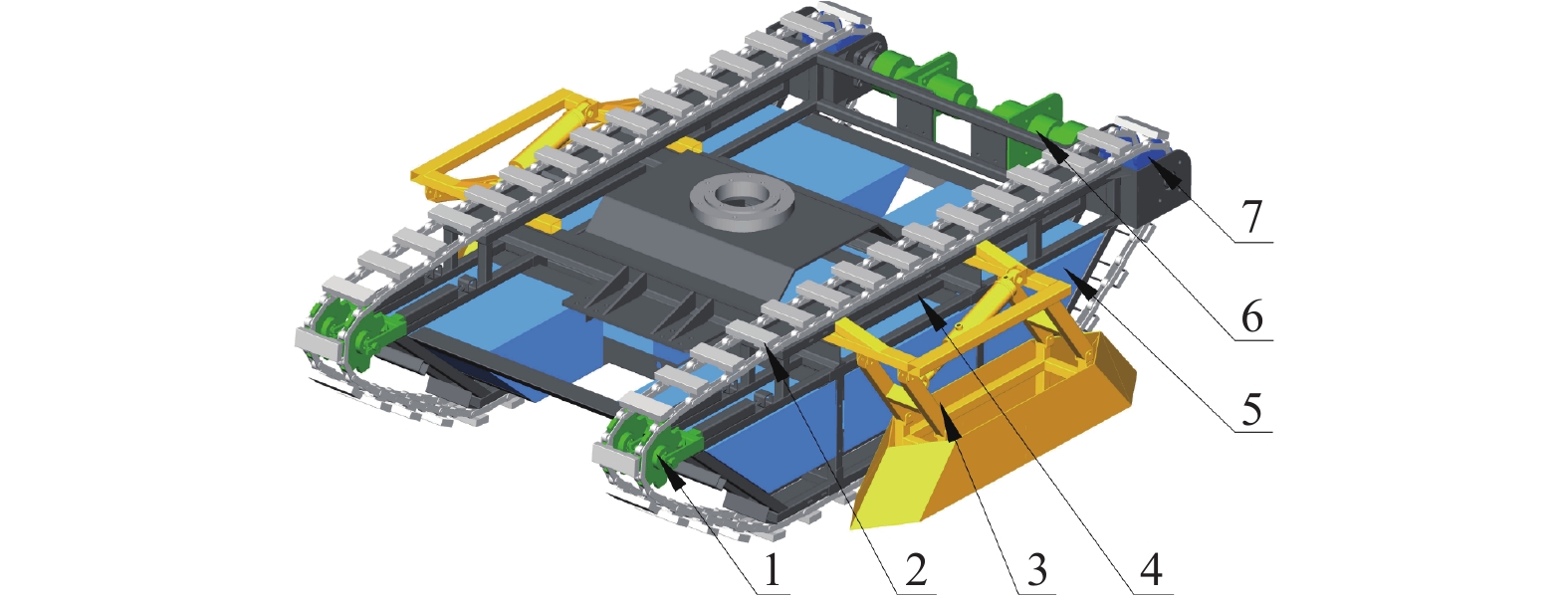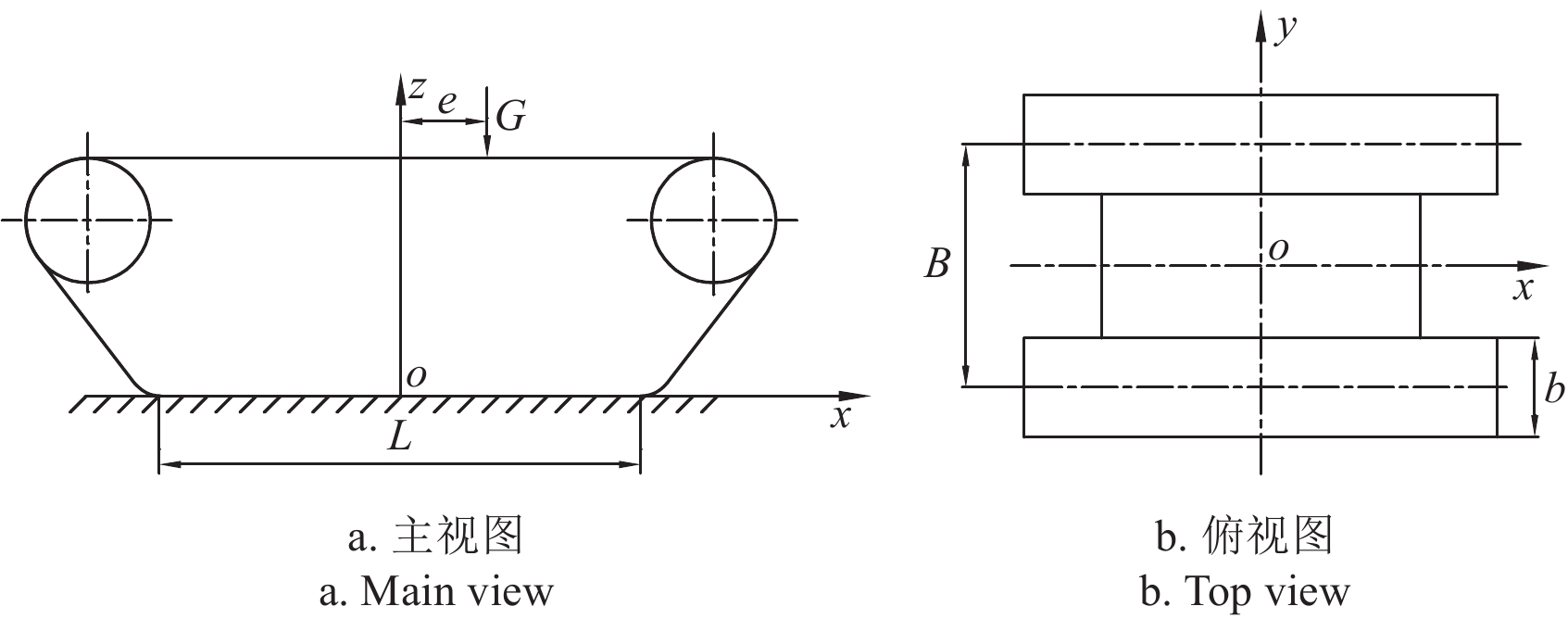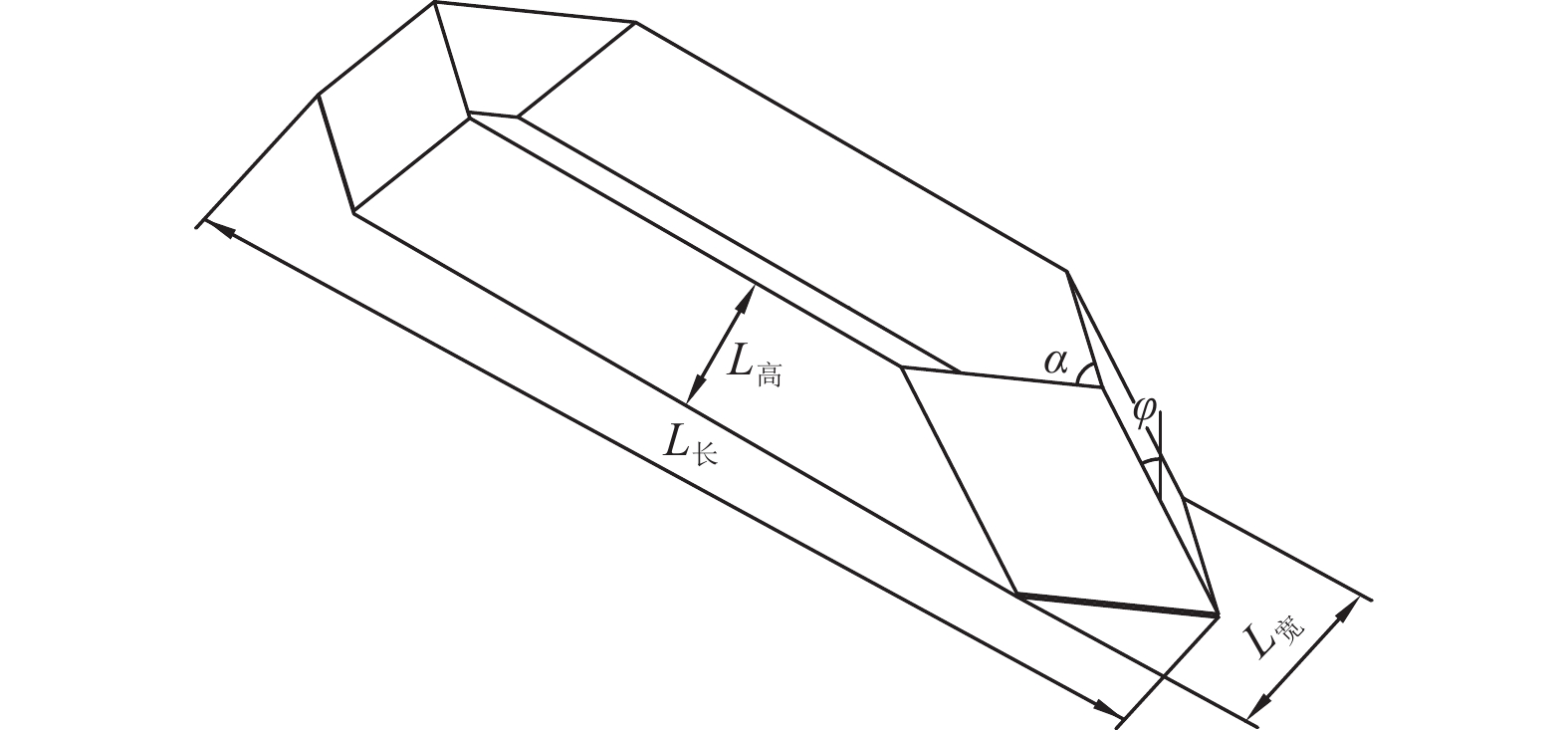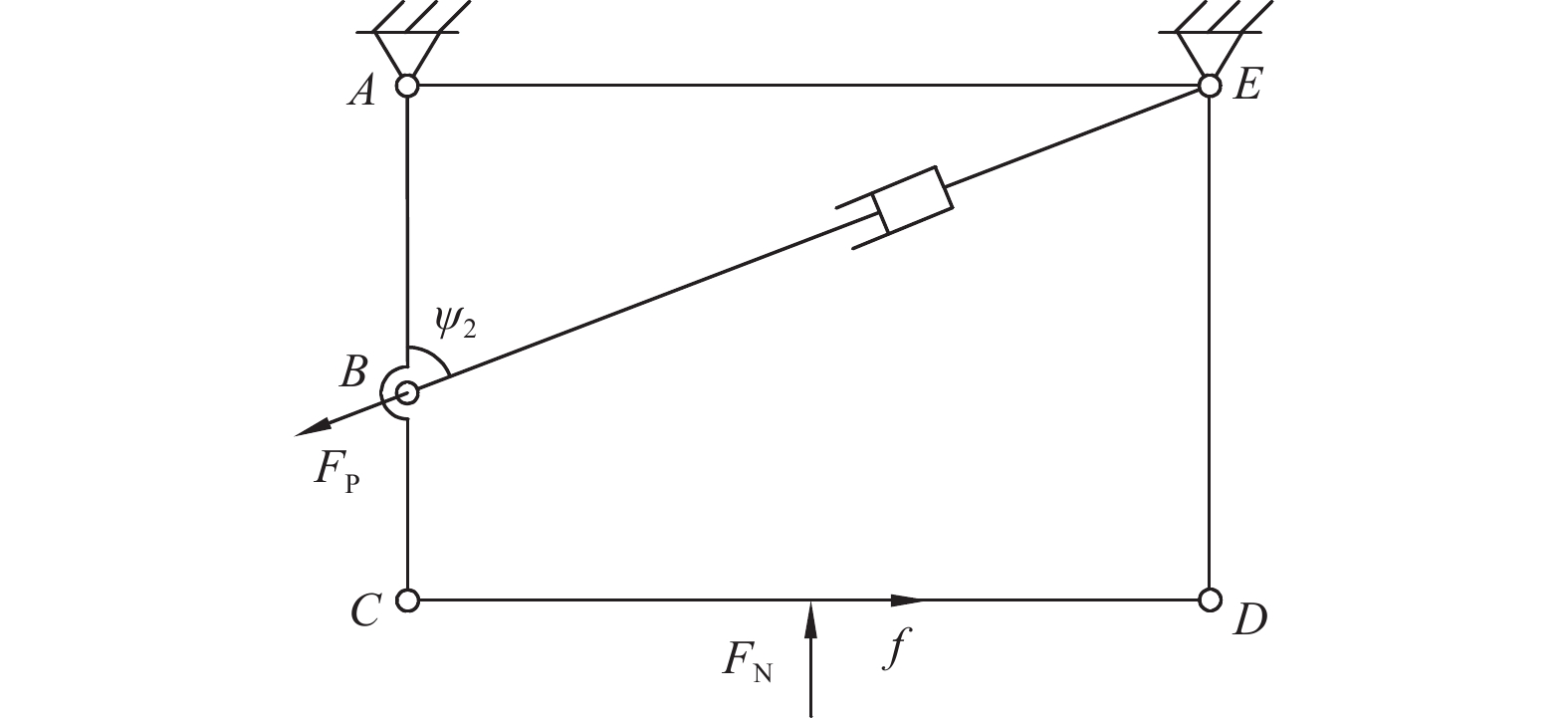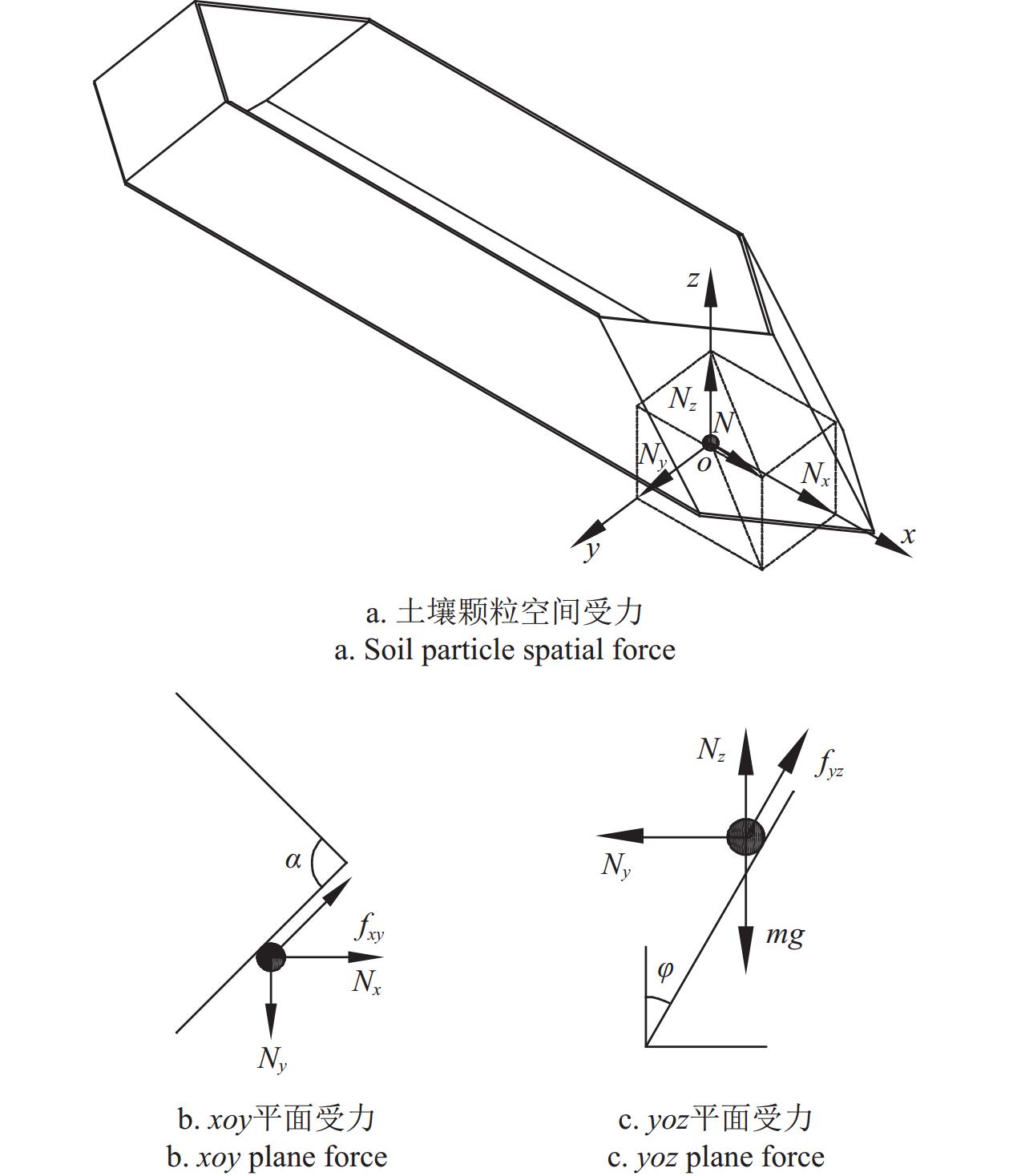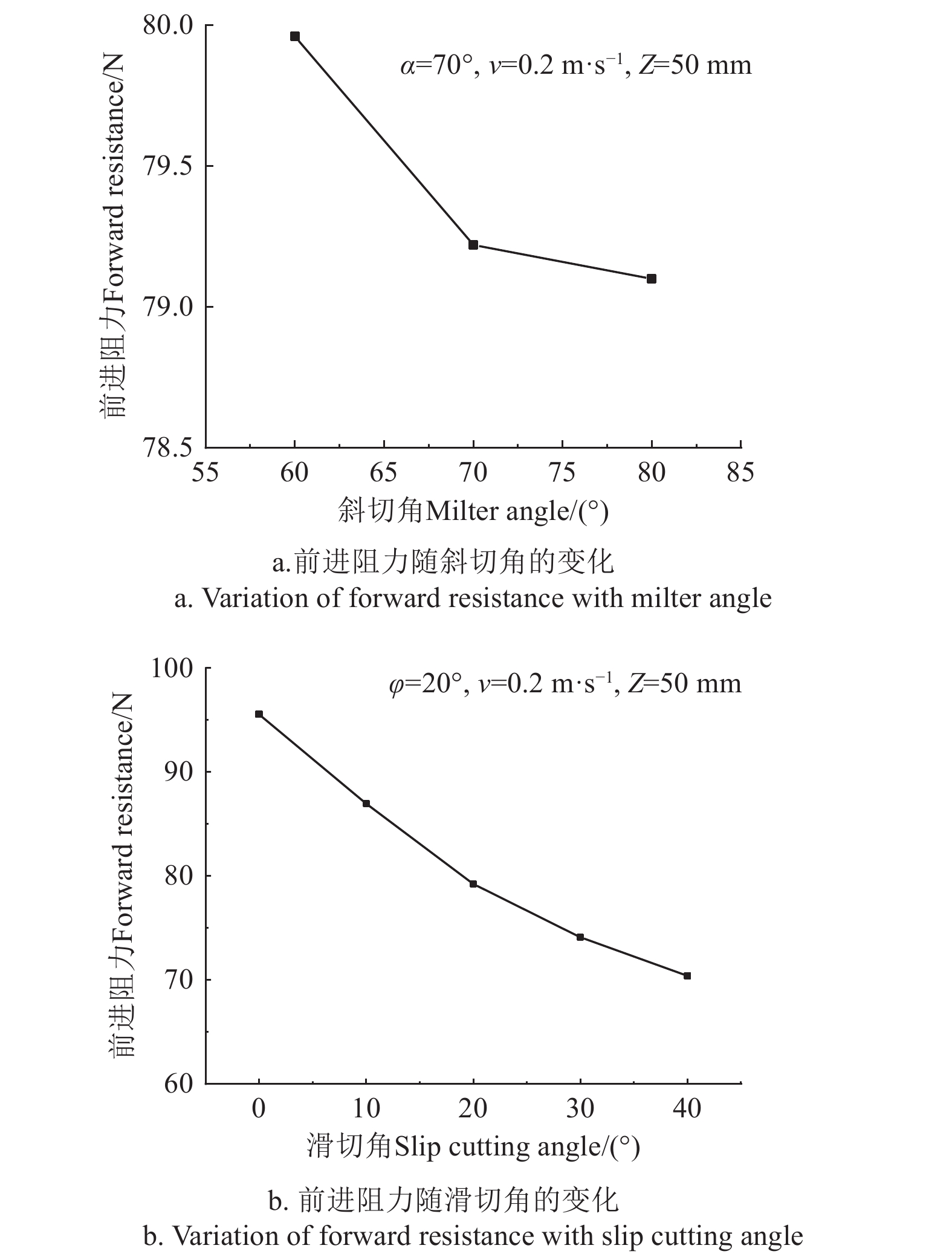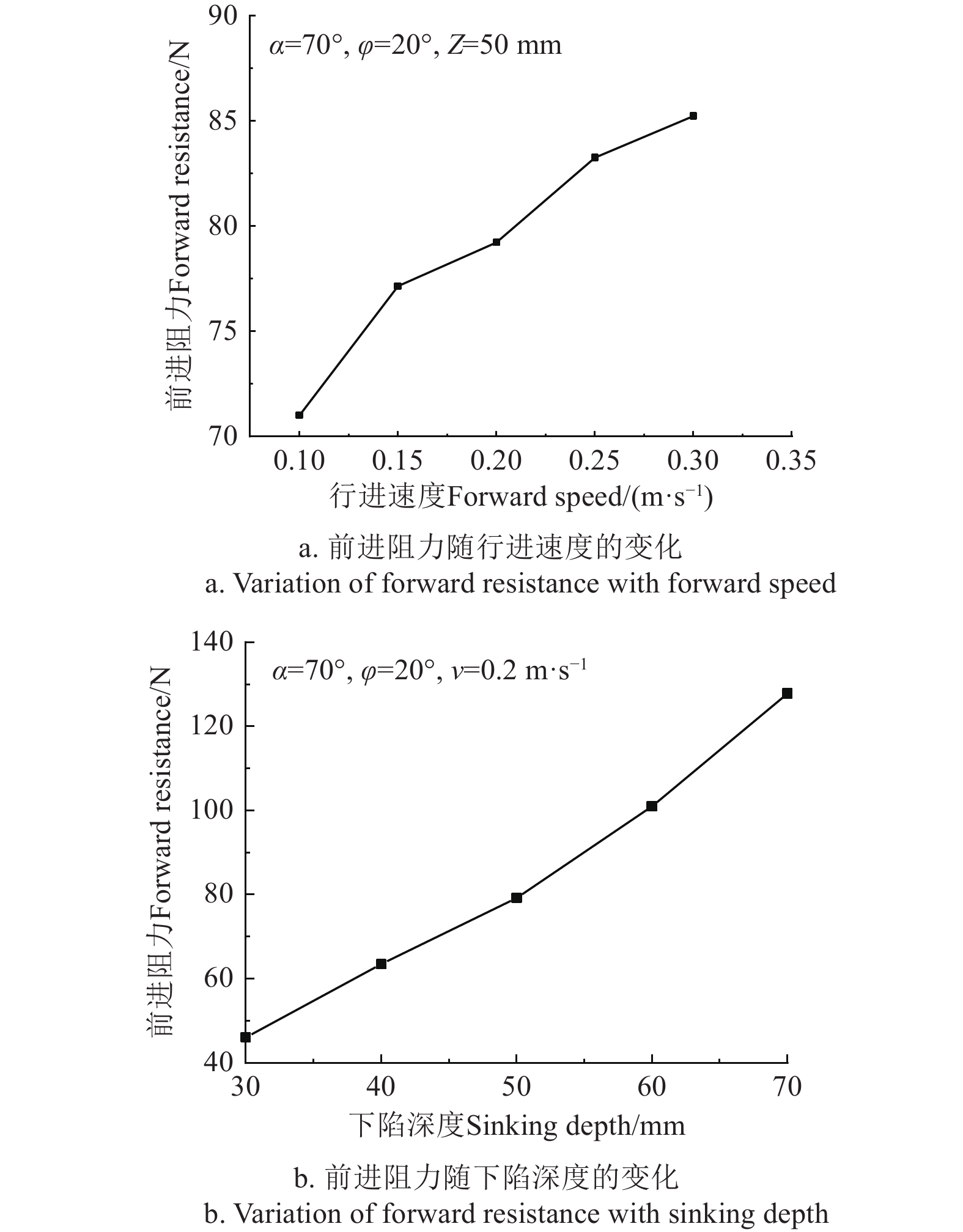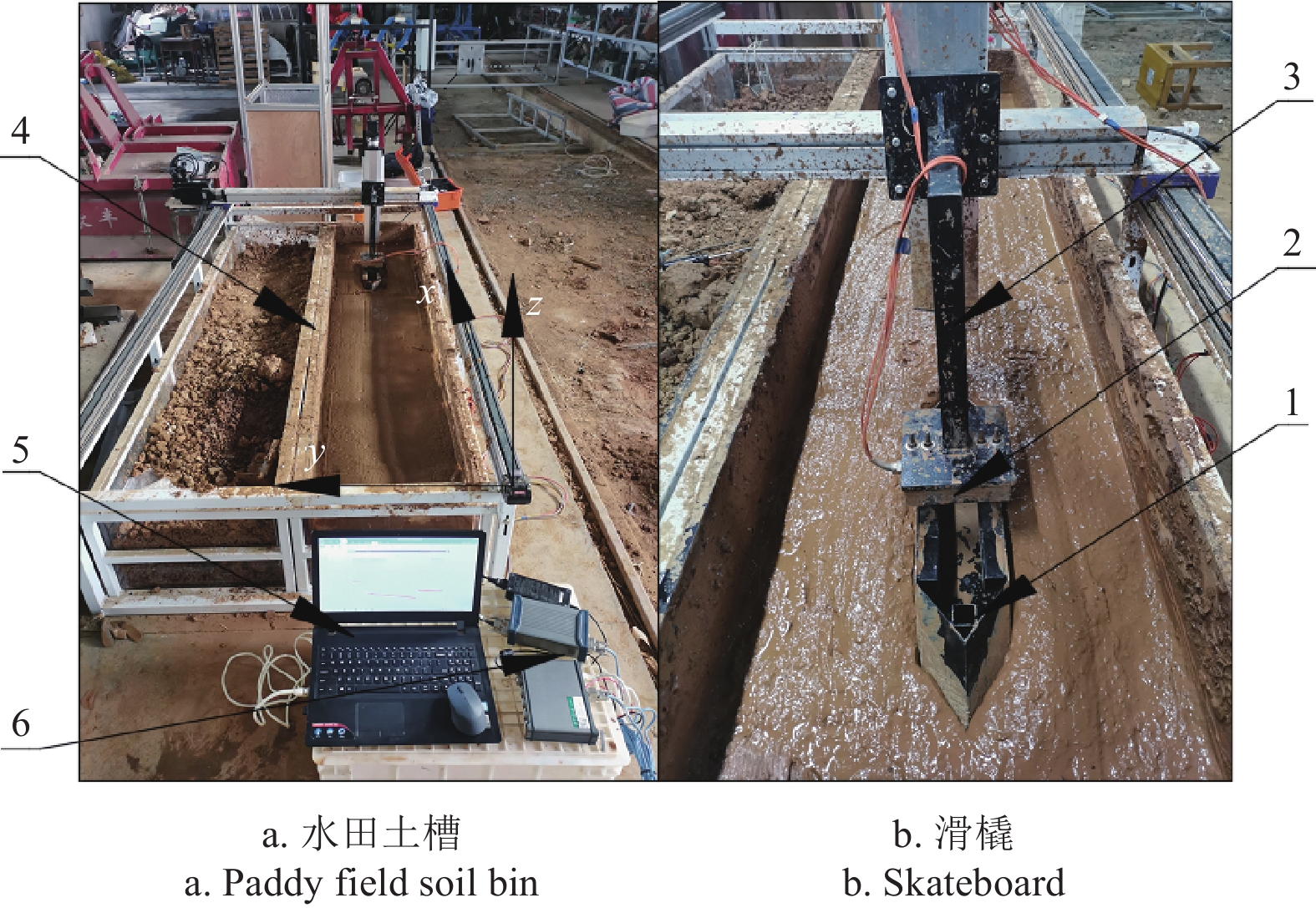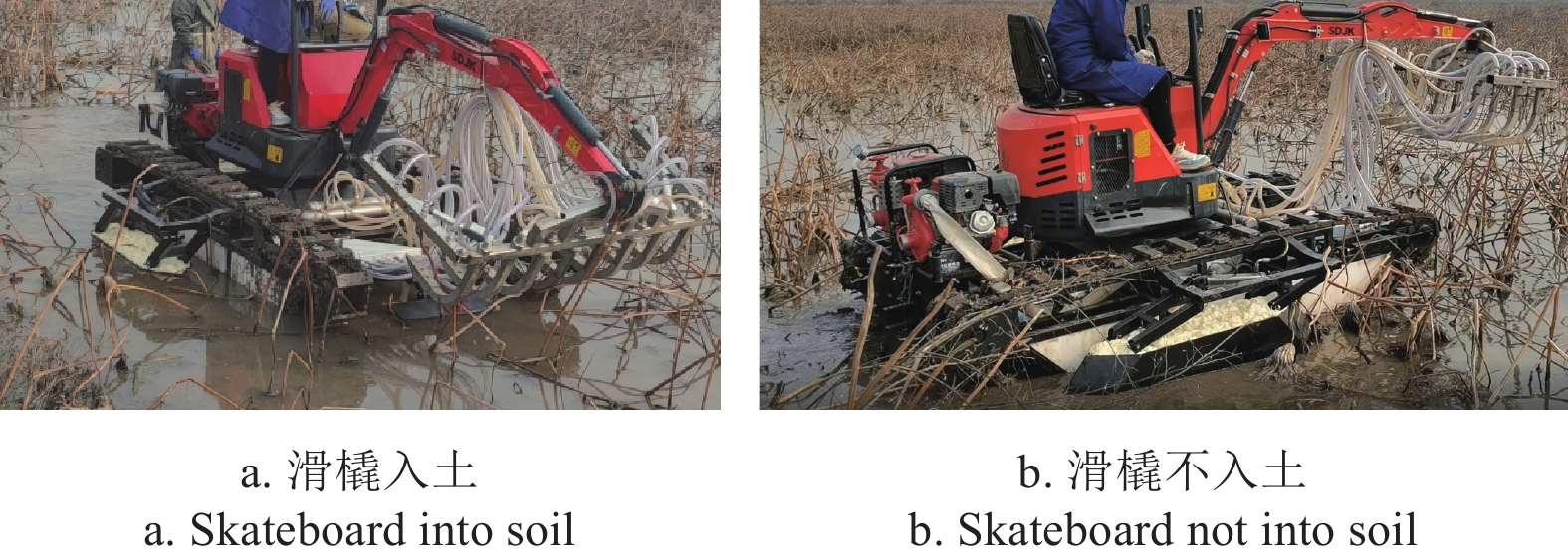Design and test of the skateboard support device for crawler float-type lotus root excavator
-
摘要:
针对履带挖藕机行驶阻力大和下陷深的问题,该研究设计了一种滑橇支承装置,该装置安装于底盘两侧,由液压驱动其上下运动调节所在位置,可辅助支撑底盘,从而降低履带接地压力和下陷深度以改善通过性。为明确增加滑橇支承装置后底盘行驶性能的变化,以履带浮筒式挖藕机底盘为对象,建立底盘行驶阻力和牵引力模型,对土壤与滑橇前端破土面间的挤压受力进行理论分析。以前进阻力为指标,建立原尺寸三分之一的滑撬比例模型,利用EDEM软件开展单因素仿真试验,获得滑切角、斜切角、行进速度和下陷深度对前进阻力的影响规律。以滑切角、斜切角、行进速度为影响因素开展Box-Behnken中心组合试验,结果表明,滑切角40°、斜切角70°、行进速度0.1 m/s时前进阻力最小,仿真模拟与台架试验结果分别为66.09和82.28 N。开展采用滑撬支承装置前后的履带浮筒式挖藕机田间行驶性能对比试验,结果显示,采用滑撬支承装置前后行驶马达阻力矩降低6.51%,底盘下陷深度降低7.64%,整机通过性得到提高。研究结果可为水田地面机器系统行走装置设计及其工作机理研究提供参考。
Abstract:The lotus root is one of the most popular food products in the stem of the lotus plant in Asia areas. Mechanical excavators of lotus roots can be expected to save the cost and labor intensity. However, the existing track float self-propelled excavator cannot fully meet the large-scale production, due to the large overall weight. There are also some difficulties in climbing, turning, and slipping vehicles in the field. In this study, the skid support device was designed to treat the high driving resistance and excess sinking of the crawler float-type excavator of lotus root. The device was installed on both sides of the chassis and hydraulically driven up and down to adjust the position. The gravity of the whole machine was supported to reduce the grounding pressure and sinking depth of the crawler. The passability was also improved as well. The driving performance of the crawler float-type excavator chassis was evaluated after the skid support device was added. The chassis of the crawler float-type excavator was taken as the research object. A new model was also established for the driving resistance and tractive force of the chassis. Theoretical analysis was conducted on the extrusion force between the soil and the ground surface at the front of the skid. The sliding-cutting angle α and milter angle φ were determined to be the main structural parameters of the driving resistance. A skid scale model was constructed for the one-third of original size. The single-factor simulation was carried out using the driving speed and sinking depth in EDEM software. A systematic investigation was made on the influence of sliding-cutting angle α, milter angle φ, driving speed v and sinking depth on the forward resistance. The results showed that the forward resistance decreased with the increase of slip angle α, and milter angle φ, whereas, there was an increase with the increase of driving speed v, and sinking depth. The box-Behnken test was also carried out to explore the influence of slip-cutting angle, milter angle and forward speed on forward resistance. The influencing factors were taken as the sliding-cutting angle α, milter angle φ, and driving speed v, while the forward resistance was the response index. It was found that the driving speed v shared a very significant effect on the forward resistance (P<0.01). The significant effect of sliding-cutting angle α, milter angle φ, and the square term v2 of driving speed v on the advancing resistance (0.01<P<0.05). The optimal combination of parameters was obtained for the skid structure. Specifically, the least forward resistance was achieved, when the sliding-cutting angle α was 40°, the milter angle φ was 70° and the driving speed v was 0.1 m/s. Correspondingly, the forward resistances were 66.09 and 82.28 N in the simulation and soil bin test, respectively. The soil bin test showed that the skid driving speed and sinking depth had very significant effects on the skid forward resistance (P<0.01). The skid driving speed and sinking depth were also proportional to the forward resistance, indicating the consistence with the simulation. The field test was carried out on the crawler float-type excavator before and after the skid support device. The resistance torque of the driving motor was reduced by 6.51%, which were 182.15 and 170.30 N·m, respectively. The sinking depth of the chassis was 178.1 and 164.5 mm, respectively, which were reduced by 7.64% than before. The performance of the excavator was outstandingly improved after adding the skid support device. This finding can provide a strong reference for the walking device of the ground machine system in paddy fields.
-
Keywords:
- chassis /
- resistance /
- skateboard /
- lotus root /
- lotus root extractor /
- passability
-
0. 引 言
莲藕是水生蔬菜,国内种植面积超25.29万hm2,年产量超749.9万t[1-3]。莲藕可生食、熟食、制药等,营养丰富,利用价值高[4-5]。收获是莲藕产业的薄弱环节,目前主要依赖人工,存在成本高、劳动强度大、高度依赖人员熟练度等问题,采挖费用接近生产成本的50%,机械采挖需求迫切[6]。藕田常年泡水,其土质黏重,承压能力差,自走式采挖机具在其间行驶时,底盘易出现陷车、行驶困难等问题。
针对莲藕采挖难题,国内研究者开发了漂浮式和自走式采挖机械。漂浮式采挖机采用浮筒[7-8]、充气轮胎[9]或船体[10-11]等底盘,浮于水面;自走式采挖机底盘与泥面接触[12-13],采用叶轮[14]、履带、螺旋滚筒[15-16]等行走装置驱动其移动。漂浮式采挖机结构简单、成本低,在藕田中移动阻力小,但作业人员需下水操作,且田间转运困难,作业效率较低。目前自走式莲藕采挖机研究较多,但仍存在下陷深、行走阻力大等问题。
作者团队前期设计了一种履带浮筒自走式挖藕机,利用浮筒浮力减小履带的接地压力,但在浅水藕田中浮筒吃水深度较小,提供的浮力有限,且浮筒固定安装于底盘下方,其高度无法调节,实际试验时,由于整机质量较大,存在爬坡、转向困难,田间陷车打滑等问题。为此,本研究通过增加滑橇支承装置对已研制的履带浮筒自走式挖藕机进行改进,滑橇支承装置安装于底盘两侧,在液压驱动下上下运动以调整其位置,可承载整机部分重力,继而降低履带下陷深度和行驶阻力。本文建立该机底盘行驶阻力和牵引力模型,对土壤与滑橇前端破土面间的挤压受力进行理论分析,确定行驶阻力的影响因素,以原尺寸三分之一的比例模型为对象开展仿真与台架试验,获得滑切角、斜切角、行进速度和下陷深度对前进阻力的影响规律,以及各影响因素的最优参数组合,获得优化的滑橇支承装置,提高履带浮筒式挖藕机底盘的通过性,以期为水田地面机器系统行走装置设计及其工作机理研究提供参考。
1. 履带浮筒式挖藕机总体结构
1.1 总体结构
履带浮筒式挖藕机总体结构如图1所示,主要由履带底盘和射流挖掘系统组成。履带底盘主要由张紧轮、履带、机架、浮筒、行驶马达以及驱动轮等组成,采用双排同步滚子链轨式履带作为行走机构,浮筒安装于机架内部,用于提供浮力;射流挖掘系统由动臂、斗杆、射流挖掘铲、连杆、摇杆、油缸等组成,在挖掘过程中水流从铲齿表面喷出,促进莲藕与土壤的分离,并降低挖掘阻力。
![]() 图 1 履带浮筒式挖藕机1.射流挖掘铲 2.连杆 3.摇杆 4.铲斗油缸 5.斗杆 6.斗杆油缸 7.动臂 8.动臂油缸 9.分水装置 10.驾驶舱 11.底盘 12.水泵 13.浮筒Figure 1. Tracked float buoy type lotus root excavator1.Jet excavator shovel 2.Connecting rod 3.Rocker 4.Bucket cylinder 5.Bucket rod 6.Bucket rod cylinder 7.Movable arm 8.Movable arm cylinder 9.Water distributor 10. Cockpit 11. Chassis 12.Water pump 13. Float buoy
图 1 履带浮筒式挖藕机1.射流挖掘铲 2.连杆 3.摇杆 4.铲斗油缸 5.斗杆 6.斗杆油缸 7.动臂 8.动臂油缸 9.分水装置 10.驾驶舱 11.底盘 12.水泵 13.浮筒Figure 1. Tracked float buoy type lotus root excavator1.Jet excavator shovel 2.Connecting rod 3.Rocker 4.Bucket cylinder 5.Bucket rod 6.Bucket rod cylinder 7.Movable arm 8.Movable arm cylinder 9.Water distributor 10. Cockpit 11. Chassis 12.Water pump 13. Float buoy滑橇支承装置安装于底盘左右两侧(如图2所示),挖藕机在田间行驶时,在液压油缸驱动下上下调节滑橇支承装置高度,使其接触和脱离土壤,可承担整机部分重力,从而降低底盘下陷量和行驶阻力。履带底盘的主要参数如表1所示。
表 1 底盘主要参数Table 1. Main parameters of chassis参数Parameters 值Value 外形尺寸(长×宽×高)
Dimension size (length×width×height)/mm3 000 ×2 600 ×800 整机质量 Overall weight /kg 1 800 动力 Power/kW 14 最大行驶速度 Maximum speed/(m·s−1) 0.3 履带宽度 Track width/mm 200 履带轨距 Track gauge/mm 1 400 履带接地长度 Track grounding length/mm 1 500 1.2 底盘通过性能分析
1.2.1 履带接地比压和下陷深度
以底盘整体为分析对象,在田间平坦地面行驶状态下,其竖直方向上受力主要有整机重力G、藕田水源提供的浮力F浮、地面对履带的支持力G1和对滑橇的支持力G2。以履带接地区段的几何中心为坐标原点O点建立坐标系,如图3所示。
研究表明[17-18],整机偏心距超过L/6时,履带接地比压呈三角形分布,部分接地段接地比压为0,对于整机行驶性能影响较大,应尽量避免;偏心距变化范围为0~L/6时,履带接地比压呈梯形分布,如图4所示。
![]() 图 4 履带接地比压梯形分布注:pa为接地比压均值,Pa;pmax为接地比压最大值,Pa;pmin为接地比压最小值,Pa;G1为地面对履带的支持力,N。Figure 4. Trapezoidal distribution of ground specific pressureNote: pa is mean value of ground specific pressure, Pa; pmax is maximum ground specific pressure, Pa; pmin is minimum ground specific pressure, Pa; G1 is support force of the ground to tract, N.
图 4 履带接地比压梯形分布注:pa为接地比压均值,Pa;pmax为接地比压最大值,Pa;pmin为接地比压最小值,Pa;G1为地面对履带的支持力,N。Figure 4. Trapezoidal distribution of ground specific pressureNote: pa is mean value of ground specific pressure, Pa; pmax is maximum ground specific pressure, Pa; pmin is minimum ground specific pressure, Pa; G1 is support force of the ground to tract, N.任意位置的接地比压px[18]为
px=G12bL(1+12eL2x) (1) 式中x为履带在xOy坐标系的接地长度,定义域为[−2/L, 2/L],mm。
由垂直载荷与土壤变形经验公式[19]可得履带底盘下陷深度为
z=(pKc/b+Kϕ)1n (2) 式中p为接地比压,Pa;n为土壤变形指数[19];Kc为土壤黏聚力模量,N/m(n+1);Kϕ为土壤内摩擦力模量,N/m(n+2);z为下陷深度,m。
由式(2)可知,接地比压不同会导致接地段下陷深度产生差异,在接地比压分布不均匀情况下,履带下陷深度主要取决于最大接地比压。
1.2.2 履带底盘行驶阻力
履带底盘在软地面行驶时,行驶阻力主要来源于土壤变形阻力、推土阻力以及行走机构的内部摩擦阻力F内,内部摩擦阻力因其与土壤参数无关,一般按照经验值进行估算,因此主要对土壤变形阻力[18]和推土阻力[20]进行分析。
土壤变形阻力FRa为
FRa=2bn+1(Kcb+Kϕ)zmax (3) 式中z_{\max} 为最大下陷深度,m。
履带底盘行驶时,履带前端会出现土壤堆积进而产生推土阻力FRb,参照作用于挡土墙上的被动土压力进行计算[20]。
{F_\text{Rb}} = 2b(0.67{K_\text{pc}}{c}{z_{\max }} + 0.5z_{\max }^2{\gamma _1}{K_\text{pγ }}) (4) 式中c为土壤黏聚强度,Pa;γ1为土壤容重,N/m3;Kpγ和Kpc为Rankine被动土压力系数。
履带直线行驶阻力FR为[20]
{F}_\text{R}={F}_\text{Ra}+{F}_\text{Rb}+{F}_{内} (5) 由式(3)~(5)可知,除土壤参数和履带自身的结构参数,履带的行驶阻力主要由最大下陷深度决定,采用滑橇支承底盘部分重力可降低履带最大下陷深度,进而降低其行驶阻力。当滑橇挤压土壤产生下陷、承受来自地面的支撑力的同时,也会承受前进方向土壤带来的阻力,该阻力主要是由于滑橇前端挤压、剪切土壤和底部的压实作用,以及与土壤接触的粘附摩擦作用所造成[21-22]。
1.2.3 履带底盘驱动力
根据图3对接地比压分布函数式(1)进行坐标变换可得:
{p_\text{x}} = \frac{{6{G_1}e}}{{b{L^3}}}x + \frac{{{G_1}}}{{2bL}}\left(1 - \frac{{6e}}{L}\right) (6) 式中x的定义域为[0, L]。
{F_\text{D}} = 2b\int_0^L {\left( {c + p_\text{x}\tan \phi } \right)} (1 - {e^{ - \sigma x/K}}){\mathrm{d}}x + {\mu _1}{G_1} (7) 式中K为土壤剪切模数,mm; \phi 为土壤摩擦角,(°);μ1为履带与地面的摩擦系数;σ为履带滑转率,%。
由式(3)~(5)可知,滑橇支承整机部分重力后,履带承重减小致使履带下陷深度减小,相应的行驶阻力也会降低,此时底盘对驱动力需求降低。但由式(6)~(7)可知,滑橇引入使得履带承受重力减少的同时,也会导致履带附着力减小,进而减小驱动力,此外滑橇引入也会另外增加行驶阻力,为此要保证滑橇引入使行驶阻力减小的比例大于驱动力的减小比例,从而使底盘行驶性能提高,因此后续针对滑橇进行减阻分析。
2. 滑橇支承装置设计
2.1 滑橇结构设计
滑橇结构如图5所示,其为一靴型空腔,为减小其前进阻力,前后两端设计破土面,用于将土壤挤压到两侧,同时在其内部增加方形结构支撑梁以避免支承整机时出现变形;在内部剩余空间中填充泡沫,防止泥土和水灌入其中,并能在藕田中提供一定浮力。
滑橇支承履带底盘时会出现沉陷,前期田间试验底盘下陷深度约为110 mm[24],考虑到滑橇前端会壅积泥土,为减少阻力,确定L高=250 mm。为获得足够支承面积以降低滑橇下陷深度,同时提供一定浮力抵消其重力,确定L宽=300 mm;考虑底盘转向时滑橇也随之转动,为避免增大转向阻力,确定L长=1500 mm。
2.2 高度调节机构
为便于机器运输,同时考虑到不同土壤承压能力不同,滑橇下陷深度需要进行调节,因此需设计滑橇支承装置高度调节机构。预设滑撬极限状态为支撑整机质量以便底盘在陷车打滑时易于脱困,因此高度调节机构采用结构稳定可靠的平行四杆机构。升降以及支撑力由液压缸提供,高度调节机构简图如图6所示。
![]() 图 6 滑橇高度调节机构简图注:A为摆杆Ⅰ与履带底盘铰接点;B为升降油缸与摆杆Ⅰ铰接点;C为摆杆Ⅰ与滑橇铰接点;D为摆杆Ⅱ与滑橇铰接点;E为摆杆Ⅱ与履带底盘铰接点;ψ1为摆杆Ⅰ与竖直垂线间夹角,(°);ψ2为升降油缸与摆杆Ⅰ间夹角,(°)。Figure 6. Sketch of skateboard height adjustment mechanismNote: A is hinge point between swing rod Ⅰ and track chassis; B is hinge point between lift cylinder and swing rod Ⅰ; C is hinge point between swing rod I and skateboard; D is hinge point between swing rod Ⅱ and skateboard E is hinge point between swing rod Ⅱ and track chassis; ψ1 is angle between swing rod I and vertical perpendicular, (°); ψ2 is angle between lift cylinder and the swing rod Ⅰ, (°).
图 6 滑橇高度调节机构简图注:A为摆杆Ⅰ与履带底盘铰接点;B为升降油缸与摆杆Ⅰ铰接点;C为摆杆Ⅰ与滑橇铰接点;D为摆杆Ⅱ与滑橇铰接点;E为摆杆Ⅱ与履带底盘铰接点;ψ1为摆杆Ⅰ与竖直垂线间夹角,(°);ψ2为升降油缸与摆杆Ⅰ间夹角,(°)。Figure 6. Sketch of skateboard height adjustment mechanismNote: A is hinge point between swing rod Ⅰ and track chassis; B is hinge point between lift cylinder and swing rod Ⅰ; C is hinge point between swing rod I and skateboard; D is hinge point between swing rod Ⅱ and skateboard E is hinge point between swing rod Ⅱ and track chassis; ψ1 is angle between swing rod I and vertical perpendicular, (°); ψ2 is angle between lift cylinder and the swing rod Ⅰ, (°).滑橇高度调节机构主要参数有机架长度、摆杆长度以及液压缸长度,综合考虑滑橇长度及原挖藕机支承梁的位置,确定机架长度lAE=800 mm。滑橇底面低于履带底面时会将整机顶起导致无法前进,因此预设滑橇最低位置保持与履带下方齐平。根据文献[25]确定滑橇最大离地高度为250 mm,结合升降机构的特点,滑橇处于最低位置时,摆杆垂直于水平面,进而确定摆杆Ⅰ长度lAC=350 mm,摆杆Ⅰ与履带底盘铰接点至摆杆Ⅰ与升降油缸铰接点的长度lAB=220 mm。
由图6几何关系可得滑橇高度与油缸长度关系如下:
{h_\text{s}} = {h_\text{a}} - {l_1}\left(1 - \sqrt {1 - {{\left(\frac{{l_\text{AE}^2 + l_4^2 - l_2^2}}{{2{l_\text{AE}}{l_4}}}\right)}^2}} \right) - {h_\text{d}} (8) 式中hd为滑橇与摆杆铰接点至滑橇底部距离,mm;ha为铰接点A至履带底部距离,mm;hs为滑橇离地高度,mm;l1为摆杆Ⅰ长度,mm;l2为升降油缸BE的长度,mm;l4为摆杆Ⅰ和摆杆Ⅱ与滑橇铰接点间C与D的距离,mm。
当滑橇处于最低位置,即摆杆Ⅰ和摆杆Ⅱ垂直于水平面时,ψ1=0,由式(8)可得:
{l_2} = \sqrt {l_\text{AE}^2 + l_4^2} (9) 此时升降油缸达到最长状态。
当滑橇处于最高位置时,由式(8)可得:
{l_1}\left( {1 - \cos {\psi _1}} \right) = 250 (10) 此时升降油缸达到最短状态,代入相关数据可得所需液压缸行程为238 mm,结合市面上销售的液压缸规格,确定行程为250 mm。
为便于履带维修和整机脱困,升降油缸所需最大推力出现在滑橇将把整机顶起时,对该状态进行受力分析,如图7所示。
此时两侧滑橇承受整机全部重力以及向后的摩擦力,油缸推力需能顶起整机,由此可得:
\left\{ \begin{gathered} {F_\text{P}}\sin {\psi _2} \gt f \\ {F_\text{N}} = \frac{1}{2}G \\ f = \mu {F_\text{N}} \\ \end{gathered} \right. (11) 式中μ为滑橇与地面的摩擦系数。
原挖藕机质量为1650 kg,增加滑橇支承装置后,在SolidWorks软件中对三维模型赋于材料属性,整机质量预计达到1800 kg,滑橇与地面的摩擦系数μ按照钢与水泥地面摩擦系数(约为0.3)进行计算,可得所需最大推力为2744 N,结合行程选择型号为40 mm×25 mm×250 mm的双作用油缸,额定压力为16 MPa,额定推力为20966 N,额定拉力为12300 N,可满足使用需求。
原挖藕机主要利用液压系统驱动底盘和挖掘装置的运动,除必要的两侧行驶马达、挖掘装置的驱动油缸、上位机回转马达,还留有2条独立液压回路用于驱动两侧滑橇升降油缸。
3. 滑橇与土壤接触离散元模拟仿真
3.1 滑橇破土面挤压力学分析
滑橇的前进阻力主要来源于与土壤的相互作用,而滑橇两端破土面以及两侧护板为主要的触土面,以滑橇破土面接触的土壤颗粒为分析对象进行动力学分析,如图8所示。
![]() 图 8 滑橇破土面挤压力学分析注:N为挤压力,N;Nx为N在x方向上的分力,N;Ny为N在y方向上的分力,N;Nz为N在z方向上的分力,N;fxy为土壤颗粒在xoy平面内所受摩擦力,N;fyz为土壤颗粒在yoz平面内所受摩擦力,N,m为土壤颗粒质量,kg;g为重力加速度,m·s-2。Figure 8. Mechanics analysis of extrusion on skateboard soil breaking surfaceNote: N is extrusion force,N; Nx is component force of N in the x-direction, N; Ny is component force of N in the y-direction , N; Nz is component force of N in the z-direction of, N; fxy is frictional force of soil particles in the xoy plane, N; fyz is frictional force of soil particles in the yoz plane, N, m is the mass of soil particles, kg; g is gravitational acceleration, m·s-2.
图 8 滑橇破土面挤压力学分析注:N为挤压力,N;Nx为N在x方向上的分力,N;Ny为N在y方向上的分力,N;Nz为N在z方向上的分力,N;fxy为土壤颗粒在xoy平面内所受摩擦力,N;fyz为土壤颗粒在yoz平面内所受摩擦力,N,m为土壤颗粒质量,kg;g为重力加速度,m·s-2。Figure 8. Mechanics analysis of extrusion on skateboard soil breaking surfaceNote: N is extrusion force,N; Nx is component force of N in the x-direction, N; Ny is component force of N in the y-direction , N; Nz is component force of N in the z-direction of, N; fxy is frictional force of soil particles in the xoy plane, N; fyz is frictional force of soil particles in the yoz plane, N, m is the mass of soil particles, kg; g is gravitational acceleration, m·s-2.由于摩擦力与挤压力为空间力,不便于直接分析,因此以土壤颗粒为原点,滑橇行进方向为x轴正方向,竖直向上为z轴正方向建立空间直角坐标系,如图8a所示,将挤压力沿坐标轴的3个方向分解,同时对土壤颗粒在xoz平面及yoz平面的受力情况进行分析,如图8b和8c所示,得到土壤颗粒沿坐标轴3个方向的动力学方程[26-27],如式(12)所示。
\left\{ \begin{aligned} & m{a_{z}} = {N_{z}} + {f_{yz}}\cos \varphi - mg \\ & m{a_{y}} = {N_{y}} - {f_{yz}}\sin \varphi \\ & m{a_{x}} = {N_{x}} + {f_{xy}}\sin \frac{\alpha }{2} \\ & {N_{y}} = {N_{x}}\tan \frac{\alpha }{2} \\ & {N_{y}} = {N_{z}}\tan \varphi \\ & {f_{yz}} = \tan \phi \sqrt {N_{y}^2 + N_{z}^2} \\ & {f_{xy}} = \tan \phi \sqrt {N_{x}^2 + N_{y}^2} \\ & N = \sqrt {N_{x}^2 + N_{y}^2 + N_{z}^2} \end{aligned} \right. (12) 式中ax为土壤颗粒在x方向上的加速度,m/s2;ay为土壤颗粒在y方向上的加速度,m/s2;az为土壤颗粒在z方向上的加速度,m/s2。
由式(12)可得:
\left\{ \begin{aligned} & {a_{x}} = \frac{{N \left(\cot \dfrac{\alpha }{2} + \tan \phi \right)}}{{m\sqrt {1 + {{\cot }^2}\dfrac{\alpha }{2} + {{\cot }^2}\varphi } }} \\ & {a_{y}} = \frac{{N(1 - \tan \phi )}}{{m\sqrt {1 + {{\cot }^2}\dfrac{\alpha }{2} + {{\cot }^2}\varphi } }} \\ & {a_{z}} = \frac{{N\cot \varphi (1 + \tan \phi )}}{{m\sqrt {1 + {{\cot }^2}\dfrac{\alpha }{2} + {{\cot }^2}\varphi } }} - g \end{aligned} \right. (13) 由式(13)可知,土壤颗粒各方向的加速度主要由土壤参数、滑橇的滑切角α和斜切角φ决定,进而确定滑切角α和斜切角φ是影响前进阻力的主要结构参数。
3.2 试验方法
对滑橇进行简化,去除加强筋等结构,用于使用原尺寸仿真计算量庞大,因此根据相似性原理采用原尺寸三分之一的比例模型进行仿真,采用Solidworks软件对滑橇模型进行绘制;模拟滑橇在田间运行的情况,在EDEM建立大小为2400 mm×400 mm×200 mm(长×宽×高)的土槽,采用颗粒工厂以box为基体静态生成大量颗粒填充其中,调整box的大小以获取相应土槽,并使土壤颗粒在重力作用下沉积,待颗粒床稳定,速度基本为零,完成土壤模型创建,最终仿真模型如图9所示。
土壤模型采用Hysteretic Spring接触模型和Linear Cohesion接触模型,保留滑橇与土壤接触的特征后导入EDEM软件中运算。
参考文献[28]设置仿真参数:颗粒直径5 mm,密度1784.72 kg/m3,泊松比0.3,弹性模量17.88 MPa;钢密度7850 kg/m3,泊松比0.3,弹性模量206.4 GPa;颗粒与颗粒间弹性恢复系数0.21,静摩擦系数0.68,动摩擦系数0.27;颗粒与工程塑料间恢复系数0.54,静摩擦系数0.20,动摩擦系数0.13。土壤颗粒阻尼系数0.95、土壤颗粒刚度0.05。
结合实际作业状态,设置滑橇仿真运动过程如下:初始时调整滑橇位置至靠近土槽短边的一侧,且其底面贴紧土壤表面,滑橇运动设置为滑橇先向下运动达到设定的下陷深度后再向前运动,向下运动时间设定为1 s,移动距离设定为1200 mm,仿真时间根据前进速度进行调整。利用EDEM软件中的图表绘制和数据输出功能(Create Graph模块)取滑橇行进方向的阻力平稳段,计算其平均值,得到滑橇前进阻力[29]。
3.3 单因素试验
由3.1节理论分析可知影响滑橇前进阻力的结构参数有滑切角α、斜切角φ,工作参数主要有行进速度v和下陷深度S,因此以这4个因素开展单因素仿真试验,确定各因素对前进阻力的影响规律,为后续优化试验提供参考。
参考芯铧式开沟器斜切角设计[30],保证土粒、秸秆等沿刃口向后滑移动而不致拥堵,斜切角φ的范围取为60°~80°。滑切角过大会导致滑橇前部过长,加剧磨损,同时参考文献[31]滑切角α范围取为0°~40°。结合现有底盘设计性能,确定行进速度为0.1~0.3 m/s,水平间隔为0.05 m/s。下陷深度同样是影响滑橇前进阻力的重要因素,结合前期田间试验测得底盘下陷深度为110 mm[24],确定模型滑撬下陷深度为30~70 mm。单因素试验水平如表2所示,试验时固定因素取中间水平。
表 2 单因素试验水平Table 2. Single factor test level水平
Level滑切角
Slip cutting angle
α/(°)斜切角
Milter angle
φ/(°)行进速度
Forward speed
v/(m·s−1)下陷深度
Sinking depth
Z/mm1 60 0 0.1 30 2 70 10 0.15 40 3 80 20 0.2 50 4 30 0.25 60 5 40 0.30 70 斜切角单因素试验结果如图10a所示,前进阻力随着斜切角增大不断减小,但在该试验条件下斜切角的变化对于前进阻力的变化影响较小。分析其原因为:斜切角增大会导致与土壤接触面积减小,进而减小滑橇摩擦阻力,但同时也使前进方向土壤推移过程更短,使得土壤反作用力增加,造成前进阻力变化较小。
滑切角单因素试验结果如图10b所示,前进阻力随滑切角增大而下降。分析其原因为:滑切角增大使得滑橇与土壤接触面积增大,导致摩擦阻力增大,同时也造成切割土壤的阻力减小,但增大滑切角对摩擦阻力的增益小于对切割阻力的减损,使得最终结果表现为负相关。
速度单因素试验结果如图11a所示,前进阻力随行进速度增加而增大。
分析其原因为:滑橇行进速度增加导致其对土壤作用时间变短,土壤获得的加速度也更大,导致前进阻力增加,同时前进方向部分土壤未及时被推移到侧边,造成滑橇前端壅积土壤,增大了前进阻力。
下陷深度单因素试验结果如图11b所示,前进阻力随着下陷深度的增加而增大。分析其原因为:随下陷深度增加,滑橇行进时扰动的土壤量也迅速增加,导致前进阻力增加[17]。
3.4 Box-Behnken试验
为探究滑切角α、斜切角φ、行进速度v对前进阻力的综合影响,以前进阻力Y为响应指标,开展3因素Box-Behnken中心组合试验,基于单因素试验结果对部分试验因素的取值进行调整,最终因素水平编码如表3所示,试验方案与结果如表4所示。
表 3 Box-Behnken仿真试验因素水平编码Table 3. Box-Behnken Simulation Test Factor Level Coding编码Code α/(°) φ/(°) v/(m·s−1) -1 30 60 0.1 0 35 65 0.2 +1 40 70 0.3 表 4 Box-Behnken仿真试验方案与结果Table 4. Box-Behnken simulation test scheme and results序号No. x1 x2 x3 前进阻力Forward resistance
Y/N1 1 -1 0 73.96 2 0 -1 -1 67.63 3 1 0 1 75.05 4 0 0 0 74.26 5 0 0 0 73.92 6 -1 1 0 75.89 7 -1 -1 0 76.42 8 0 1 1 74.90 9 -1 0 -1 67.86 10 1 1 0 70.21 11 -1 0 1 78.52 12 0 0 0 73.30 13 0 0 0 71.19 14 0 -1 1 78.63 15 0 0 0 75.81 16 1 0 -1 66.94 17 0 1 -1 66.44 注:x1、x2和x3 为滑切角、斜切角和行进速度的编码值。 Note: x1、x2 and x3 are the values of slip cutting angle、milter angle and forward speed. 前进阻力Y的方差分析结果如表5所示。由表5可知,该回归模型极显著(P<0.01),而失拟项不显著(P>0.05),表明回归方程拟合度较好,行进速度对前进阻力影响极显著(P<0.01),滑切角、斜切角和行进速度的平方项对前进阻力影响均显著(0.01<P<0.05),其余项对前进阻力影响均不显著(P>0.05),各因素对前进阻力影响的主次顺序为:行进速度、滑切角、斜切角。
表 5 前进阻力方差分析Table 5. Analysis of variance for forward resistance变异来源
Variation source平方和
Sum of squares自由度
Degree of freedom均方
Mean squareF P 模型Model 234.3 9 26.03 13.87 0.0011** x1 19.63 1 19.63 10.45 0.0144** x2 10.58 1 10.58 5.64 0.0493* x3 182.69 1 182.69 97.3 <0.0001** x1x2 2.59 1 2.59 1.38 0.2784 x1x3 1.63 1 1.63 0.87 0.383 1 x2x3 1.61 1 1.61 0.86 0.3848 x12 0.40 1 0.40 0.21 0.6584 x22 0.06 1 0.06 0.03 0.8673 x32 15.39 1 15.39 8.2 0.0242* 纯误差Pure error 11.27 4 2.82 失拟项Lack of fit 1.87 3 0.62 0.221 0.8774 总和Total 482.02 16 注:**表示影响极显著,P<0.01;*表示影响显著,0.01≤P<0.05,下同。 Note: **indicates that the impact is extremely significant, P<0.01; * indicates that the impact is significant, 0.01≤P<0.05, the same below. 剔除对前进阻力影响不显著的项后得到各因素与前进阻力Y间的回归方程为
Y = 73.696 - 1.57{x_1} - 1.15{x_2} - 4.78{x_3} - 1.91x_3^2 (14) 各因素交互作用响应面如图12所示。
滑切角取35°时,行进速度与斜切角对前进阻力的交互作用如图12a所示,由图可知,当行进速度一定时,斜切角增大则前进阻力降低,降低趋势较为平缓;而当斜切角大小保持不变时,随着行进速度增大,前进阻力逐渐增大,且上升较快。当行进速度为0.1 m/s时,滑橇前进阻力基本不随斜切角的改变而发生变化。
斜切角取65°时,行进速度与滑切角对前进阻力的交互作用如图12b所示,由图可知,当行进速度一定时,滑切角增大则前进阻力降低,降低趋势较为平缓;当滑切角大小保持不变时,随着行进速度增大,前进阻力逐渐增大,且上升较快。当行进速度为0.1 m/s时,滑橇前进阻力基本不随滑切角的改变而发生变化。
行进速度取0.2 m/s时,斜切角与滑切角对前进阻力的交互作用如图12c所示,由图可知,当斜切角保持一致时,随着滑切角增大,前进阻力逐渐降低,降低趋势较为平缓;当滑切角大小保持不变时,随着斜切角增大,前进阻力逐步减小。当斜切角为60°时,滑橇前进阻力基本不随滑切角的改变而发生变化。
借助Design-Expert软件进行滑橇参数的优化分析,得到最佳参数组合为:滑切角α为40°、斜切角φ为70°、行进速度v为0.1 m/s,对应前进阻力为65.18 N,以最优参数组合开展3次仿真验证试验,试验结果取均值为66.09 N,与预测值误差为1.38%。
4. 室内土槽试验
根据仿真试验优化结果,试制滑橇缩小模型开展室内土槽试验,对比最优结构参数下实际试验与仿真试验的差距,并以下陷深度、行进速度为试验因素,以滑橇前进阻力作为试验指标开展室内土槽试验,验证滑橇下陷深度、行进速度对前进阻力的影响规律。
4.1 试验装置
试验装置主要由水田土槽试验系统、三维力传感器、DH3820N测试系统组成(如图13所示)。水田土槽试验系统主要包括土槽、驱动装置、控制装置,土槽本体内设置有两个用于盛放土壤的容置腔,本文台架试验仅使用一侧的容置腔。驱动装置设置于土槽的上方且其上设置有安装架,能够驱动安装架沿土槽本体的三轴方向移动。三维力传感器通过L型连接架与固定安装板连接,其底部通过螺栓与滑橇顶部连接。容置腔大小为2400 mm×400 mm×400 mm(长×宽×高),土壤深度为200 mm。
由水田土槽试验系统驱动滑橇在土壤中的移动,通过安装于固定安装板与滑橇之间的三轴力传感器测量滑橇在移动过程中的前进阻力,由于传感器输出的为电压信号,通过DH3820N测试系统和计算机对电压信号进行处理,最终获得滑橇移动过程的前进阻力。
4.2 试验与方法
试验用土壤取自华中农业大学试验田,取回后置于水田土槽的容置腔内,经充分泡水后使用微型旋耕机对土壤进行充分粉碎混合,并使用刮土板调整土壤的平整度。随机选取土槽泥面下5和10 cm的土壤各3组,采用SDH-1202快速卤素水分测试仪测定其含水率,测得泥面下5和10 cm处样品含水率分别为34.99%和 35.29%。
试验时使用竖直方向电机调节滑橇高度,使滑橇底部刚好贴紧泥面,然后按照设定值将滑橇压入预定下陷深度位置,到达后,按照设定的移动速度启动长边驱动电机,滑橇在其驱动下沿土槽长边方向移动,并记录数据。为减小滑橇行进方向的壅泥与土槽内壁接触对前进阻力造成的影响,滑橇停止位置前方预留一段缓冲区域,结合模型滑橇长度确定移动距离为1200 mm。
将滑橇移动速度调整为0.1 m/s,下陷深度调整为50 mm,以与仿真试验优化的结果对应,该验证试验重复3次后取平均值。
为验证下陷深度、行进速度对滑橇前进阻力的影响规律,以行进速度及下陷深度为试验因素,水平选取与前文仿真试验设置一致,选取行进方向阻力为试验指标,试验因素与水平编码如表6所示。
表 6 双因素水平Table 6. Two-factor level水平Level Z/mm v/(m·s−1) 1 30 0.1 2 50 0.2 3 70 0.3 4.3 结果与分析
验证试验结果分别为87.98、71.23和87.64 N,平均值为82.28 N,与仿真试验结果相差19.68%,分析造成上述误差的原因主要为:由前文可知土槽内不同深度土壤含水率存在差异,特别是滑橇与土壤接触后,对土壤产生了扰动,使土壤特性发生了变化,与离散元仿真参数设置存在差异;滑橇从启动到停止过程中速度存在波动,测试装置有震动;每次试验时的土壤平整度和下陷深度难以保持精准一致。综上因素造成试验结果有波动,且与仿真试验结果误差较大。
双因素试验方案与结果如表7所示。
表 7 双因素试验方案与结果Table 7. Two-factor test scheme and results序号No. Z/mm v/(m·s−1) Y/N 1 30 0.1 72.98 2 30 0.2 89.11 3 30 0.3 107.70 4 50 0.1 82.28 5 50 0.2 115.88 6 50 0.3 143.99 7 70 0.1 121.60 8 70 0.2 136.86 9 70 0.3 153.46 对试验结果进行方差分析,分析结果如表8所示。
表 8 前进阻力方差分析Table 8. Analysis of variance for forward resistance变异来源
Variation source平方和
Sum of squares自由度
Degree of freedom均方
Mean squareF P 模型Model 6110.41 4 1527.60 22.02 0.0055** Z 3367.20 2 1683.60 24.27 0.0058** v 2743.21 2 1371.61 19.77 0.0084** 残差Residual 277.45 4 69.36 总计Total 6387.86 8 根据方差分析表,滑橇行进速度和下陷深度对滑橇前进阻力的影响均为极显著(P<0.01),滑橇行进速度、下陷深度均与前进阻力成正比,与仿真结果的规律一致。
5. 田间试验
5.1 试验条件
试验地点为湖北省武汉市江夏区金口镇武当村莲藕种植基地,试验设备包括卤素水分测试仪(浙江赛德仪器设备有限公司,SDH-1202,±0.01%)、土壤紧实度仪(山东恒美电子科技有限公司,HM-JSD,±0.1%FS)、油压表、直尺、卷尺、秒表等,试验田块内平均水深200 mm,泥脚深度约为200 mm,200 mm深度土壤的平均坚实度和含水率分别为386 kPa,41.64%。
5.2 试验方法
将履带浮筒式挖藕机停放在起点位置后,以底盘右侧履带外缘为基准线,以履带右侧前方接地点为起点,沿基准线向前13 m作为终点,预留3 m作为底盘的加速距离,控制升降油缸抬升或下降滑橇,使得滑橇接触或离开土壤,开展田间性能对比试验。选取下陷深度、行驶马达阻力矩作为评价指标。各指标测试方法如下所示:
下陷深度:以履带内侧土壤未下陷区为测量基准,使用直尺测量履带碾压区域内下陷深度。行驶试验完成后,沿运动方向在碾压区域随机选取10个测量点,在每个测量点沿横向在左右履带碾压区域各选取1点,取二者平均值作为该点下陷深度的测量值。
行驶马达阻力矩:考虑到直线行驶时,两侧液压马达压力差异不大,因此仅测量单侧马达压力,将压力表连接到左侧液压马达进出油口,通过预实验可知在行驶状态比较稳定时压力表示数也会较为稳定,因此待示数稳定后记录其值。
行驶马达阻力矩按式(15)计算。
T = \frac{{Pq}}{{2 \times 3.14 \times w}}{\text{ = }}\frac{{PQ}}{{6.28}} (15) 式中T为行驶马达阻力矩,N·m;P为液压马达压力,Pa;q为流量,L/min;Q为行驶马达排量,L/r;w为转速,r/min。
5.3 结果与分析
履带浮筒式挖藕机田间直线行驶滑橇支承装置入土与否性能对比试验现场如图14所示,结果显示滑橇不入土和入土,履带底盘的行驶马达阻力矩分别为182.15和170.30 N·m,滑橇入土时的马达阻力矩比不入土时降低了6.51%;履带下陷深度分别为178.1和164.5 mm,滑橇入土时比不入土时履带下陷深度降低了7.64%。
行驶马达的阻力矩变化取决于行驶阻力的变化。田间试验结果表明履带底盘的行驶阻力有所降低。履带接地段下陷深度能够反映底盘的通过性能,其值越小代表通过性能越好,载重能力更强;滑橇入土支承整机部分重量后上述指标均有所下降,图14 表明挖藕机通过性能得到改善。
6. 结 论
1)本研究设计了一种滑橇支承装置,安装于底盘左右两侧,在液压油缸作用下辅助支承整机部分重力,从而降低底盘下陷量和行驶阻力。
2)为探究滑切角、斜切角、行进速度对前进阻力的综合影响,开展Box-Behnken中心组合试验,建立了以前进阻力为目标的多元回归模型,对滑切角、斜切角、行进速度进行了参数优化,最优参数组合为滑切角40°、斜切角70°、行进速度0.1 m/s,此时仿真试验的平均前进阻力为66.09 N,台架试验结果为82.28 N,与仿真试验结果相差19.68%。以下陷深度和行进速度开展了双因素台架试验,试验结果表明行进速度对前进阻力影响极显著(P<0.01),与仿真规律一致。
3)开展了田间滑橇入土与否对照试验,滑橇不入土和入土时履带底盘的行驶马达阻力矩分别为182.15和170.30 N·m,滑橇入土时的马达阻力矩比不入土时降低了6.51%;履带下陷深度分别为178.1和164.5 mm,滑橇入土时的履带下陷深度比不入土时下降了7.64%。
-
图 1 履带浮筒式挖藕机
1.射流挖掘铲 2.连杆 3.摇杆 4.铲斗油缸 5.斗杆 6.斗杆油缸 7.动臂 8.动臂油缸 9.分水装置 10.驾驶舱 11.底盘 12.水泵 13.浮筒
Figure 1. Tracked float buoy type lotus root excavator
1.Jet excavator shovel 2.Connecting rod 3.Rocker 4.Bucket cylinder 5.Bucket rod 6.Bucket rod cylinder 7.Movable arm 8.Movable arm cylinder 9.Water distributor 10. Cockpit 11. Chassis 12.Water pump 13. Float buoy
图 4 履带接地比压梯形分布
注:pa为接地比压均值,Pa;pmax为接地比压最大值,Pa;pmin为接地比压最小值,Pa;G1为地面对履带的支持力,N。
Figure 4. Trapezoidal distribution of ground specific pressure
Note: pa is mean value of ground specific pressure, Pa; pmax is maximum ground specific pressure, Pa; pmin is minimum ground specific pressure, Pa; G1 is support force of the ground to tract, N.
图 6 滑橇高度调节机构简图
注:A为摆杆Ⅰ与履带底盘铰接点;B为升降油缸与摆杆Ⅰ铰接点;C为摆杆Ⅰ与滑橇铰接点;D为摆杆Ⅱ与滑橇铰接点;E为摆杆Ⅱ与履带底盘铰接点;ψ1为摆杆Ⅰ与竖直垂线间夹角,(°);ψ2为升降油缸与摆杆Ⅰ间夹角,(°)。
Figure 6. Sketch of skateboard height adjustment mechanism
Note: A is hinge point between swing rod Ⅰ and track chassis; B is hinge point between lift cylinder and swing rod Ⅰ; C is hinge point between swing rod I and skateboard; D is hinge point between swing rod Ⅱ and skateboard E is hinge point between swing rod Ⅱ and track chassis; ψ1 is angle between swing rod I and vertical perpendicular, (°); ψ2 is angle between lift cylinder and the swing rod Ⅰ, (°).
图 8 滑橇破土面挤压力学分析
注:N为挤压力,N;Nx为N在x方向上的分力,N;Ny为N在y方向上的分力,N;Nz为N在z方向上的分力,N;fxy为土壤颗粒在xoy平面内所受摩擦力,N;fyz为土壤颗粒在yoz平面内所受摩擦力,N,m为土壤颗粒质量,kg;g为重力加速度,m·s-2。
Figure 8. Mechanics analysis of extrusion on skateboard soil breaking surface
Note: N is extrusion force,N; Nx is component force of N in the x-direction, N; Ny is component force of N in the y-direction , N; Nz is component force of N in the z-direction of, N; fxy is frictional force of soil particles in the xoy plane, N; fyz is frictional force of soil particles in the yoz plane, N, m is the mass of soil particles, kg; g is gravitational acceleration, m·s-2.
表 1 底盘主要参数
Table 1 Main parameters of chassis
参数Parameters 值Value 外形尺寸(长×宽×高)
Dimension size (length×width×height)/mm3 000 ×2 600 ×800 整机质量 Overall weight /kg 1 800 动力 Power/kW 14 最大行驶速度 Maximum speed/(m·s−1) 0.3 履带宽度 Track width/mm 200 履带轨距 Track gauge/mm 1 400 履带接地长度 Track grounding length/mm 1 500 表 2 单因素试验水平
Table 2 Single factor test level
水平
Level滑切角
Slip cutting angle
α/(°)斜切角
Milter angle
φ/(°)行进速度
Forward speed
v/(m·s−1)下陷深度
Sinking depth
Z/mm1 60 0 0.1 30 2 70 10 0.15 40 3 80 20 0.2 50 4 30 0.25 60 5 40 0.30 70 表 3 Box-Behnken仿真试验因素水平编码
Table 3 Box-Behnken Simulation Test Factor Level Coding
编码Code α/(°) φ/(°) v/(m·s−1) -1 30 60 0.1 0 35 65 0.2 +1 40 70 0.3 表 4 Box-Behnken仿真试验方案与结果
Table 4 Box-Behnken simulation test scheme and results
序号No. x1 x2 x3 前进阻力Forward resistance
Y/N1 1 -1 0 73.96 2 0 -1 -1 67.63 3 1 0 1 75.05 4 0 0 0 74.26 5 0 0 0 73.92 6 -1 1 0 75.89 7 -1 -1 0 76.42 8 0 1 1 74.90 9 -1 0 -1 67.86 10 1 1 0 70.21 11 -1 0 1 78.52 12 0 0 0 73.30 13 0 0 0 71.19 14 0 -1 1 78.63 15 0 0 0 75.81 16 1 0 -1 66.94 17 0 1 -1 66.44 注:x1、x2和x3 为滑切角、斜切角和行进速度的编码值。 Note: x1、x2 and x3 are the values of slip cutting angle、milter angle and forward speed. 表 5 前进阻力方差分析
Table 5 Analysis of variance for forward resistance
变异来源
Variation source平方和
Sum of squares自由度
Degree of freedom均方
Mean squareF P 模型Model 234.3 9 26.03 13.87 0.0011** x1 19.63 1 19.63 10.45 0.0144** x2 10.58 1 10.58 5.64 0.0493* x3 182.69 1 182.69 97.3 <0.0001** x1x2 2.59 1 2.59 1.38 0.2784 x1x3 1.63 1 1.63 0.87 0.383 1 x2x3 1.61 1 1.61 0.86 0.3848 x12 0.40 1 0.40 0.21 0.6584 x22 0.06 1 0.06 0.03 0.8673 x32 15.39 1 15.39 8.2 0.0242* 纯误差Pure error 11.27 4 2.82 失拟项Lack of fit 1.87 3 0.62 0.221 0.8774 总和Total 482.02 16 注:**表示影响极显著,P<0.01;*表示影响显著,0.01≤P<0.05,下同。 Note: **indicates that the impact is extremely significant, P<0.01; * indicates that the impact is significant, 0.01≤P<0.05, the same below. 表 6 双因素水平
Table 6 Two-factor level
水平Level Z/mm v/(m·s−1) 1 30 0.1 2 50 0.2 3 70 0.3 表 7 双因素试验方案与结果
Table 7 Two-factor test scheme and results
序号No. Z/mm v/(m·s−1) Y/N 1 30 0.1 72.98 2 30 0.2 89.11 3 30 0.3 107.70 4 50 0.1 82.28 5 50 0.2 115.88 6 50 0.3 143.99 7 70 0.1 121.60 8 70 0.2 136.86 9 70 0.3 153.46 表 8 前进阻力方差分析
Table 8 Analysis of variance for forward resistance
变异来源
Variation source平方和
Sum of squares自由度
Degree of freedom均方
Mean squareF P 模型Model 6110.41 4 1527.60 22.02 0.0055** Z 3367.20 2 1683.60 24.27 0.0058** v 2743.21 2 1371.61 19.77 0.0084** 残差Residual 277.45 4 69.36 总计Total 6387.86 8 -
[1] 吴茜,刘智勇,李国文,等. 莲藕的功能特性及其产品开发前景分析[J]. 食品与发酵科技,2020,56(6):108-112. WU Qian, LIU Zhiyong, LI Guowen, et al. Analysis of functional characteristics and product development prospect of Lotus root[J]. Food and Fermentation Science and Technology, 20, 56(6): 108-112. (in Chinese with English abstract)
[2] 谢晋,韩迪,王靖,等. 中国莲藕产业发展现状及展望[J]. 农业展望,2017,13(12):42-45,51. doi: 10.3969/j.issn.1673-3908.2017.12.009 XIE Jin, HAN Di, WANG Jing, et al. Development status and prospect of lotus root industry in China[J]. Agricultural Outlook, 2017, 13(12): 42-45,51. (in Chinese with English abstract) doi: 10.3969/j.issn.1673-3908.2017.12.009
[3] 贾乐,刘瑞玲,房祥军,等. 莲藕采后主要致腐真菌分离鉴定及生物学特性研究[J]. 核农学报,2022,36(3):661-668. JIA Le, LIU Ruiling, FANG Xiangjun, et al. Isolation, identification and biological characteristics of main postharvest rot fungi in lotus root[J]. Journal of Nuclear Agronomic Science, 202, 36(3): 661-668. (in Chinese with English abstract)
[4] 雷丹,李军胜,李书艺,等. 莲藕可溶性膳食纤维与多酚复合物的稳定性及脂肪吸附活性研究[J]. 中国食品学报,2022,22(2):31-39. LEI Dan, LI Junsheng, LI Shuyi, et al. Study on the stability and lipid adsorption activity of soluble dietary fiber and polyphenol complex of Lotus root[J]. Chinese Journal of Food Science, 202, 22(2): 31-39. (in Chinese with English abstract)
[5] 刘春菊,钱旻,宋江峰,等. 速冻莲藕片贮藏过程中品质变化动力学模型[J]. 农业工程学报,2017,33(6):301-308. doi: 10.11975/j.issn.1002-6819.2017.06.039 LIU Chunju, QIAN Min, SONG Jiangfeng, et al. Establishment of dynamic model for quality change in frozen lotus root slices during storage[J]. Transactions of the Chinese Society of Agricultural Engineering (Transactions of the CSAE), 2017, 33(6): 301-308. (in Chinese with English abstract) doi: 10.11975/j.issn.1002-6819.2017.06.039
[6] 李峰,周雄祥,柯卫东,等. 湖北省莲产业发展调研报告[J]. 湖北农业科学,2020,59(23):101-106,109. LI Feng, ZHOU Xiongxiang, KE Weidong, et al. Research report on the development of lotus industry in Hubei Province[J]. Hubei Agricultural Sciences, 20, 59(23): 101-106,109. (in Chinese with English abstract)
[7] 黄琳,周勇,张国忠,等. 手扶水力冲刷式挖藕机设计与试验[J]. 华中农业大学学报,2021,40(5):207-216. HUANG Lin, ZHOU Yong, ZHANG Guozhong, et al. Design and experiment of hand-supported Hydraulic scour lotus root excavator[J]. Journal of Huazhong Agricultural University, 2021, 40(5): 207-216. (in Chinese with English abstract)
[8] 林一涛. 乘坐式浮筒挖藕机设计与试验[D]. 武汉:华中农业大学,2019. LIN Yitao. Design and Experiment of Riding Buoy Lotus Root Digging Machine[D]. Wuhan: Huazhong Agricultural University, 2019. (in Chinese with English abstract)
[9] 吴昊,夏俊芳,张国忠,等. 基于EDEM-Fluent仿真的自旋射流式挖藕机的设计与试验[J]. 农业工程学报,2018,34(5):9-14. doi: 10.11975/j.issn.1002-6819.2018.05.002 WU Hao, XIA Junfang, ZHANG Guozhong, et al. Design and experiment of spin jet flow lotus root digger based on edem-fluent simulation[J]. Transactions of the Chinese Society of Agricultural Engineering (Transactions of the CSAE), 2018, 34(5): 9-14. (in Chinese with English abstract) doi: 10.11975/j.issn.1002-6819.2018.05.002
[10] 黄海东,张国忠,夏俊芳,等. 4CWO-3.2型船式挖藕机的研制[J]. 湖北农机化,2008(3):24-25. [11] 王维,顾宝兴,姬长英. 4SWJ-1型船式水力挖藕机研制[J]. 农业机械,2009(4):88-90. [12] 高雪峰,洪占勇,姚友丹. 大功率莲藕采收机的研制[J]. 农机化研究,2021,43(2):94-98. GAO Xuefeng, HONG Zhanyong, YAO Youdan. Development of high-power lotus root harvester[J]. Journal of Agricultural Mechanization Research, 201, 43(2): 94-98. (in Chinese with English abstract)
[13] 刘莫尘,梁文倩,肖化超,等. 履带式自走水力采藕机设计与试验[J]. 农业机械学报,2023,54(S2):61-70. doi: 10.6041/j.issn.1000-1298.2023.S2.007 LIU Mochen, LIANG Wenqian, XIAO Huachao, et al. Design and experiment of crawler type self-propelled hydraulic lotus root harvester[J]. Transactions of the Chinese Society for Agricultural Machinery, 2023, 54(S2): 61-70. (in Chinese with English abstract) doi: 10.6041/j.issn.1000-1298.2023.S2.007
[14] 郭洋民. 水田莲藕采挖机设计与研究[D]. 武汉:华中农业大学,2015. GUO Yangmin. Design and Research of Lotus Root Mining Machine in Paddy Field[D]. Wuhan: Huazhong Agricultural University, 2015. (in Chinese with English abstract)
[15] 冯闯闯,周勇,涂鸣,等. 螺旋推进式挖藕机的设计与试验[J]. 甘肃农业大学学报,2020,55(4):191-199. FENG Chuangchuang, ZHOU Yong, TU Ming, et al. Design and experiment of screw propelled type lotus root digging machine[J]. Journal of Gansu Agricultural University, 2020,55 (4):191-199 . (in Chinese with English abstract)
[16] 刘沿. 双螺旋推进式挖藕机关键部件设计与试验[D]. 武汉:华中农业大学,2022. LIU Yan. Design and Experiment of Key Components of Double Driven Lotus Root Digger[D]. Wuhan: Huazhong Agricultural University, 2022. (in Chinese with English abstract)
[17] 燕碧娟,刘泽坤,王志霞等. 排岩机履带行走装置接地比压分布规律研究[J]. 机械设计与制造, 2024, (04): 12-16. YAN Bijuan, LIU Zekun, WANG Zhixia, KOU Baofu. Study on the distribution law of ground specific pressure of crawler moving device of heavy spreader[J]. Machinery Design & Manufacture, 2024, (04): 12-16. (in Chinese with English abstract)
[18] 杨红旗. 工程机械履带-地面附着力矩理论基础[M]. 北京:机械工业出版社,1990. [19] 迟媛,张荣蓉,任洁,等. 履带车辆差速转向时载荷比受土壤下陷的影响[J]. 农业工程学报,2016,32(17):62-68. doi: 10.11975/j.issn.1002-6819.2016.17.009 CHI Yuan, ZHANG Rongrong, REN Jie, et al. Steering power ratio affected by soil sinkage with differential steering in tracked vehicle[J]. Transactions of the Chinese Society of Agricultural Engineering(Transactions of the CSAE), 2016, 32(17): 62-68. (in Chinese with English abstract) doi: 10.11975/j.issn.1002-6819.2016.17.009
[20] 张克健. 车辆地面力学[M]. 北京:国防工业出版社,2002. [21] 王永维,何焯亮,王俊. 船式拖拉机船型参数对滑行阻力与下陷深度的影响[J]. 浙江大学学报(农业与生命科学版),2020,46(6):759-766. WANG Yongwei, HE Choliang, WANG Jun. Effects of boat-type parameters of boat-type tractor on working resistance and subsidence depth[J]. Journal of Zhejiang University (Agriculture and Life Sciences ), 2020, 46(6): 759-766. (in Chinese with English abstract)
[22] 张明华,罗锡文,王在满,等. 水稻精量穴直播机仿形与滑板机构的优化设计与试验[J]. 农业工程学报,2017,33(6):18-26. ZHANG Minghua, LUO Xiwen, WANG Zaiman, et al. Optimization design and experiment of profiling and slide board mechanism of precision rice hill-drop drilling machine[J]. Transactions of the Chinese Society of Agricultural Engineering(Transactions of the CSAE), 2017, 33(6): 18-26. (in Chinese with English abstract)
[23] 许焰,吴鸿云,左立标. 履齿高度对集矿机牵引性能的影响及参数确定[J]. 农业工程学报,2012,28(11):68-74. doi: 10.3969/j.issn.1002-6819.2012.11.012 XU Yan, WU Hongyun, ZUO Libiao. Influence of shoe tooth height of tracked vehicle on traction performance and its parameter determination[J]. Transactions of the Chinese Society of Agricultural Engineering(Transactions of the CSAE), 2012, 28(11): 68-74. (in Chinese with English abstract) doi: 10.3969/j.issn.1002-6819.2012.11.012
[24] 白国瑞,张国忠,姚荣苗,等. 履带浮筒式挖藕机底盘设计与试验[J]. 安徽农业大学学报,2022,49(4):659-665. BAI Guorui, ZHANG Guozhong, YAO Rongmiao, et al. Design and test of chassis of crawler pontoon lotus root digger[J]. Journal of Anhui Agricultural University, 2022, 49(4): 659-665. (in Chinese with English abstract)
[25] 中国农业机械化科学研究院. 农业机械设计手册(下)[M]. 北京:中国农业科学技术出版社,2007. [26] 李尚平,潘家枫,钟家勤,等. 基于有效落种空间的甘蔗横向种植机开沟器设计与试验[J]. 农业机械学报,2022,53(7):162-170. LI Shangping, PAN Jiafeng, ZHONG Jiaqin, et al. Design and experiment of ditch cutter for sugarcane horizontal planter based on effective seed dropping space[J]. Transactions of the Chinese Society for Agricultural Machinery, 202, 53(7): 162-170. (in Chinese with English abstract)
[27] 吕金庆,衣淑娟,陶桂香,等. 马铃薯播种机分体式滑刀开沟器参数优化与试验[J]. 农业工程学报,2018,34(4):44-54. doi: 10.11975/j.issn.1002-6819.2018.04.006 LYU Jinqing, YI Shujuan, TAO Guixiang, et al. Parameter optimization and experiment of splitter sliding-knife opener for potato planter[J]. Transactions of the Chinese Society of Agricultural Engineering(Transactions of the CSAE), 2018, 34(4): 44-54. (in Chinese with English abstract) doi: 10.11975/j.issn.1002-6819.2018.04.006
[28] 焦俊,张国忠,杜俊,等. 莲藕主藕体弯曲破坏离散元仿真分析[J]. 华中农业大学学报,2021,40(5):217-225. JIAO Jun, ZHANG Guozhong, DU Jun, et al. Discrete element simulation of bending failure of main lotus root[J]. Journal of Huazhong Agricultural University, 2021, 40(5): 217-225. (in Chinese with English abstract)
[29] 马跃进,王安,赵建国,等. 基于离散元法的凸圆刃式深松铲减阻效果仿真分析与试验[J]. 农业工程学报,2019,35(3):16-23. doi: 10.11975/j.issn.1002-6819.2019.03.003 MA Yuejin, WANG An, ZHAO Jianguo, et al. Simulation analysis and experiment of drag reduction effect of convex blade subsoiler based on discrete element method[J]. Transactions of the Chinese Society of Agricultural Engineering(Transactions of the CSAE), 2019, 35(3): 16-23. (in Chinese with English abstract) doi: 10.11975/j.issn.1002-6819.2019.03.003
[30] 中国农业机械化科学研究院. 农业机械设计手册(上)[M]. 北京:中国农业科学技术出版社,2007. [31] 杨秀丽,陈彬,邢航,等. 滑刀开沟-气力引射式液肥雾化侧深施肥装置设计与试验[J]. 农业工程学报,2023,39(16):13-25. doi: 10.11975/j.issn.1002-6819.202212124 YANG Xiuli, CHEN Bin, XING Hang, et al. Design and experiments of the side-deep fertilization device with sliding-knife furrow opener and pneumatic ejector for a liquid fertilizer atomizer[J]. Transactions of the Chinese Society of Agricultural Engineering(Transactions of the CSAE), 2023, 39(16): 13-25. (in Chinese with English abstract) doi: 10.11975/j.issn.1002-6819.202212124




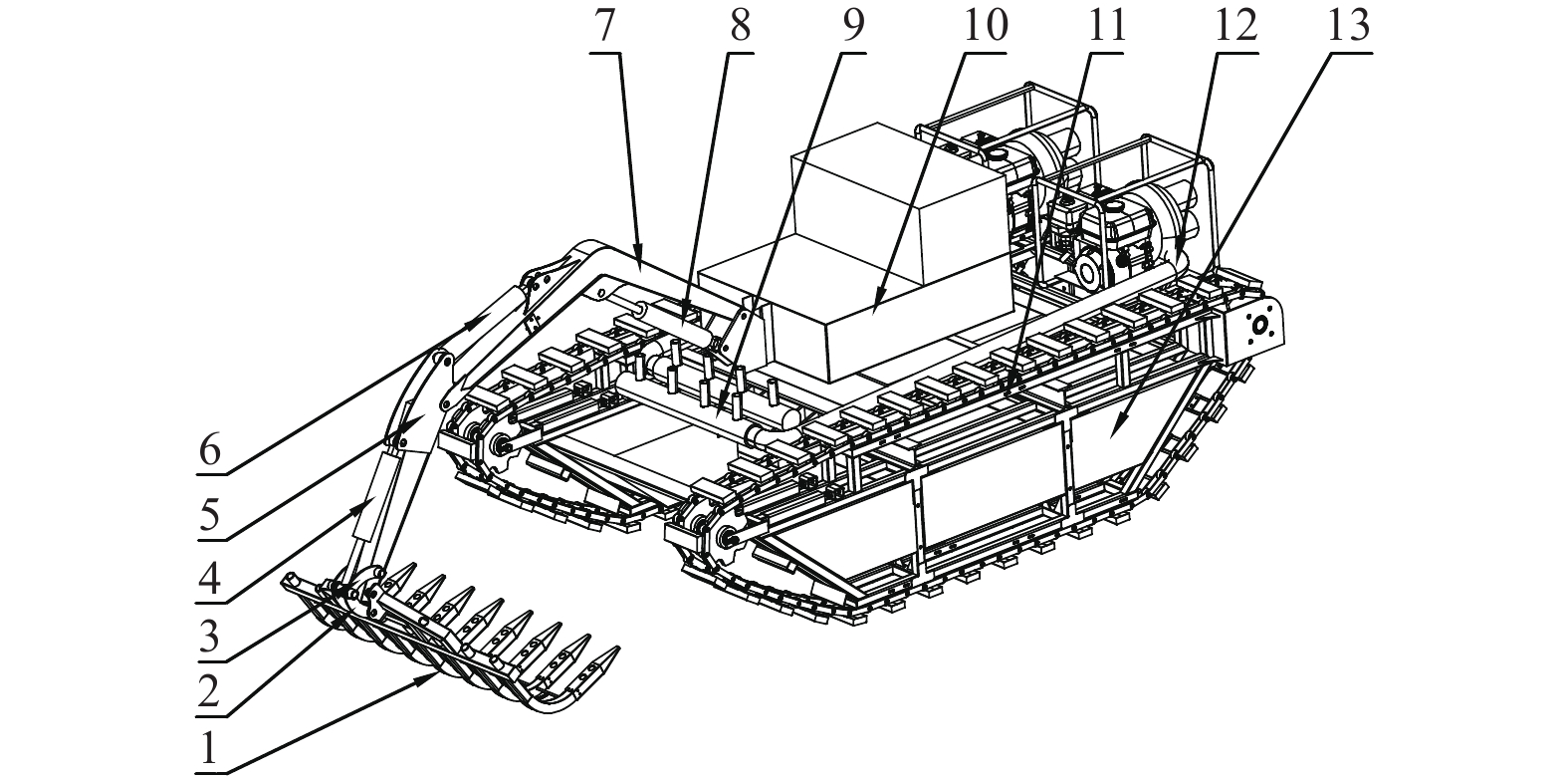
 下载:
下载:
